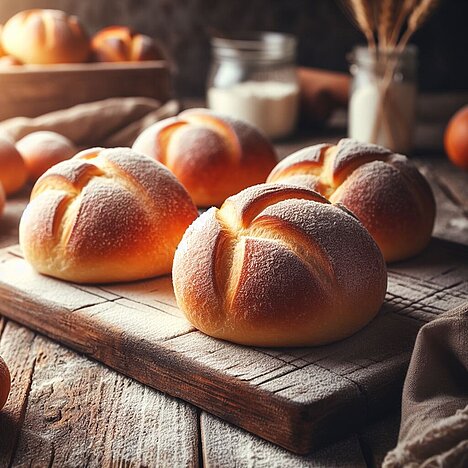Bread roll

What are bread rolls?
A bread roll is a small pastry made from yeast dough. The dough is formed into round or oblong shapes and cut with a sharp knife or scored with scissors. This creates the typical crust that cracks during baking. Bread rolls are available in many different varieties, for example with grains, seeds, nuts or spices. Some rolls are also treated with caustic soda to give them a dark color and a spicy taste. These are called lye rolls.
Bread rolls are mainly eaten for breakfast, but also as a snack between meals or as an accompaniment to soups or salads. They are usually topped with butter, jam, cheese, sausage or other spreads. Bread rolls are very popular in Germany and are available in almost every bakery. There are also many recipes for baking rolls yourself.
What are the benefits of bread rolls for dogs?
Bread rolls can have several benefits for dogs if they are fed in moderation. Firstly, bread rolls can be a source of carbohydrates, which provide the dog with energy. Carbohydrates are not essential for dogs, but they can aid digestion and increase food intake. Secondly, bread rolls can be a source of fiber, which can also aid digestion and regulate bowel movements. In addition, bread rolls can be a source of vitamins and minerals, depending on the types of flour and ingredients used. For example, wheat flour can contain vitamins B1, B2, B3 and B6, as well as iron, magnesium and zinc. Rye flour can contain vitamin E, folic acid and copper, as well as more fiber than wheat flour. Grains, seeds and nuts can also provide vitamin E, omega-3 fatty acids and antioxidants.
What are the disadvantages of bread rolls for dogs?
Bread rolls can also have some disadvantages for dogs if they are fed too often or too much. For one, bun can lead to obesity if it exceeds the dog's calorie requirements. Bun has about 250 to 300 kilocalories per 100 grams, which is about 10 to 15 percent of a medium-sized dog's daily requirement. On the other hand, bread rolls can lead to intolerances or allergies if the dog is sensitive to certain types of flour or ingredients. Wheat flour in particular can lead to digestive problems such as flatulence, diarrhea or vomiting in some dogs. Other types of grain such as rye or barley can also contain gluten, which can trigger an allergic reaction in some dogs. In addition, some ingredients such as nuts or spices can be poisonous or harmful to dogs.
How can you feed your dog bread rolls?
If you want to feed buns to your dog, there are a few things you should keep in mind to reap the benefits and avoid the drawbacks. Here are some tips:
- Feed buns only as an occasional treat or supplement to regular food, not as a staple food.
- Only feed buns in small amounts, for example a quarter or half a bun a day, depending on your dog's size and activity level.
- Only feed bread rolls when they are fresh, not when they are old, dry or moldy.
- Feed buns without spreads or toppings that are unsuitable for dogs, such as butter, jam, chocolate, onions or garlic.
- Feed buns without ingredients that are intolerable or allergic to dogs, such as wheat flour, gluten, nuts or spices.
- Feed buns without ingredients that are toxic or harmful to dogs, such as raisins, grapes, macadamia nuts or salt.
- Feed buns only in whole pieces or in large chunks, not in small crumbs or slices that the dog could swallow or choke on.
- Monitor your dog for signs of intolerance or allergy after feeding buns, such as itching, rash, coughing, sneezing or difficulty breathing. If you notice such signs, you should no longer give your dog bread rolls.
Rolls are a delicious pastry made from a yeast dough with different types of flour and ingredients. It can have some benefits for dogs, such as carbohydrates, fiber and vitamins. But it can also have some disadvantages, such as obesity, intolerance or allergy. If you want to feed buns to your dog, you should only give them as an occasional treat or supplement, in small quantities and when fresh. You should also pay attention to the ingredients and watch your dog for possible reactions. This way you can make your dog happy and protect his health.
Properties 9
Are you looking for other ingredients with a specific property?
Just click on them to find more.
If you notice any signs of hypersensitivity or poisoning in your dog, you should see your vet immediately. We are not a substitute for a vet, but we try to be as accurate as possible. Every dog reacts differently and we recommend you get a second opinion or consult your vet if in doubt.
Stay healthy and take good care of your four-legged friend!😊
Similar to Bread roll
White bread is bread baked from wheat flour that has been separated from the outer layers of the grain. As a result, it contains less fiber, vitamins and minerals than whole grain bread. In...
Wholemeal bread is bread that is baked from wholemeal flour. Wholemeal flour contains all the components of the grain kernel, i.e. the germ, the endosperm and the husk. This means that it contains...
Baguette contains no toxic ingredients for dogs such as chocolate, raisins or onions.Baguette can be used as a reward or as an activity for dogs. For example, you can spread a piece of baguette with...
A croissant can be a tasty treat for dogs to enjoy from time to time. It contains carbohydrates, which provide energy, and fat, which is important for healthy skin and coat. Croissants can also...


